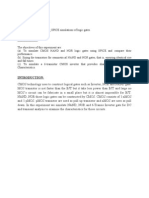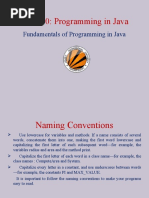0 ratings0% found this document useful (0 votes)
30 viewsJava Notes 2
Java pdf notes
Uploaded by
aloklkr570Copyright
© © All Rights Reserved
We take content rights seriously. If you suspect this is your content, claim it here.
Available Formats
Download as PDF or read online on Scribd
0 ratings0% found this document useful (0 votes)
30 viewsJava Notes 2
Java pdf notes
Uploaded by
aloklkr570Copyright
© © All Rights Reserved
We take content rights seriously. If you suspect this is your content, claim it here.
Available Formats
Download as PDF or read online on Scribd
You are on page 1/ 8
22 Programming in Java
2.7 PROGRAM STRUCTUR'
‘A Java application con!
defined as an instance o
and methods) specified
operations on the fields an
Figure 2.7).
Ses 1ST
fa collectio s. A class is asemeats i Object
sists of aC Z pject) contains the members
ce (obj (fie
fhe class. Each instance 7 aa value. A method ag
in the class. A fi ents to th
tn oe vues that ae passed. 86 STE © Method (so,
E pena
n of classe’
Instruction
Local variables
Instruction
Local variables
Class and Instance variables
Figure 2.7. Program structure
Let us now create our first Java program. Example 2.1 below shows a very simple
‘Java program which displays a string on the console. It has just-one print statement (The
program is explained in Section 2.7.3).
BSR RS SARE TT
Example 2.1 First Java Program
PuiXy 7 Cal] this file “Example. java” */
L2k/ Class Example {
Puss) //your program starts execut:
‘jon with a
/*\4*/ public static void main (String args[ ae oe
/US*/——System.out.printIn(“This i
fat 8 This is a simple Java program”):
Puree.
2.7.1 How to Execute a Java Program
There i
are three easy steps for Successfully executing a J
Y g a Java program:
1, Entering the source code The above program (Example 2.1) can be written in
any text editor (like Notepad) but make sure it is written exactly the same way it is
shown.
2. Saving the source code Now that you’ve written the code in Notepad, this is how
you'll save it
© Select File | Save As from the notepad menu.
¢ Inthe ‘File name’ field, type “Example. java” within double quotes
Inthe ‘Save as type’ field select All Files Cs),
© Click enter to save the file
3. Compiling and running the source Java programs are compiled using DOS. For
opening DOS, type cmd at the run prompt and move to the folder that contains the
saved Example. java file. Now compile the program using javac, specifying the name
of the source file on the command line as shown below. (assuming the file was saved
in a folder javaeg in the C drive.)
C:\> cd javaeg // change to directory javaeg using cd command
C:\javaeg\>javac Example. java
The javac compiler creates a file called Example.class (in the same directory). This
class contains the bytecode version of the program. This bytecode will be executed by
the Java interpreter using java followed by the class name as shown below.
C:\javaeg\>java Example
The output of the program is shown below:
This is a simple Java program
VARIABLES icntiaesisinaraiamene name rSiersoneespouiae TGA SRA
Variable is a symbolic name to refer to a memory location used to store values that can
change during the execution of a program. Java declares its variables in the following
manner:
int noOfWatts == 100; // variable declaration
Data type Identifier Literal
A variable declaration involves specifying the type (data type), name (identifier),
and value (literal) according to the type of the variable. Let us have a look at the three
components in detail.
3.2 PRIMITIVE DATA TYPES
Primitive types are the basic building blocks of any programming language. A pr;
‘i ies Mitive
data type can have only one value at a time and is the simplest built-in form Of dag
within Java. All variables in Java have to be declared before they can be used, Which
is why Java is termed as a strongly typed language. There are eight primitive type, 7
Java, as follows:
byte
short
|-—> For Whole Number
int
long
float
| For Real Numbers
double —__J
char» Characters
boolean———» Boolean
Java is portable across com,
puter platforms. C and C+ leave the size of data types to
the machine and the compiler.
, but Java specifies everything.
“© Allinteger (byte, short, int, long) and floating-point types (float, double) are
signed in Java.
byte: It is a 1-byte (8-bit) signed 2”
to 127 (inclusive). The byte
savings actually matter.
$ complement integer. It ranges from -128
data type can be used where the memory
short: It is a 2-byte (16-bit) signed 2’s complement integer. It ranges from
—32,768 to 32,767 (inclusive). As with byte, you can use a short to save
memory.
int: It is a 4-byte (32-bit) signed 2’s complement integer. It ranges from
~2,147,483,648 to 2,147,483,64
data type is the default choice,
long: It is an 8-byte (64-bit) si
~9,223,372,036,854,775
This data type should b
wider than int.
7 (inclusive). For integral values, this
igned 2’s complement integer. It ranges from
808 to 9,223,372,036,854,775,807 (inclusive).
e used only when you need a range of values
Floating point conforms to the IEEE 754-1985 binary floating point standard.
float: It is a single-precision 32-bit f1
joating point. It ranges from
1.4012984643248 1 7e-45f to 3.40282
'3476638528860e+38f.
Java Programming Constructs 49
double: This data type is a double-precision 64-bit floating point. It ranges from
4,94065645841246544e-324 to 1.79769313486231570e+308. For
decimal numbers, this data type is the default choice.
boolean: Ithas only two possible values: true and false. The size of this data type
is not precisely defined,
char: The unsigned char data type is a single 16-bit Unicode character. It ranges
from *\u0000° (or 0) to ‘\uffff’ (or 65,535 inclusive).
"Unlike C/C++, where handling of character sequences is tedious, Java provides
a class named “String” for handling character strings enclosed within double
quotes. Although, not a primitive data type, Java String solves much of the
complexity with ease.
3.3 IDENTIFIER sostsatianiesnsnnatssasnennmuene teria eae amen
Identifiers are names assigned to variables, constants, methods, classes, packages, and
interfaces. No limit has been specified for the length of a variable name. Identifiers can
have letters, numbers, underscores, and any currency symbol. However they may only
begin with a letter, underscore, or a dollar sign. Digits cannot be the first character in an
identifier.
3.3.1 Rules for Naming
. The first character of an identifier must be a /etter, an underscore, or a dollar sign
(8).
Use /etter, underscore, dollar sign, or digit for subsequent characters. Note that
white spaces are not allowed within identifiers.
v
. Identifiers are case-sensitive. This means that Total Price and total_price are
different identifiers.
4, Do not use Java’s reserved keywords.
A few examples of legal and illegal identifiers are shown below.
MyClass Wy Class
amount 23amount,
_totalPay -totalpay
total_Connission total@conmission
50 Programming in Java
3.3.2 Naming Convention
Names should be kept according 10
as shown in Fig. 3.1.
their usage, as it is meaningful and easy to remembe,
eae
> ___ > | Package Declaration
— hello 3 ase claetence
ies
ie Sd Importing Other Packages
Cee ee
public class Hel loworld Class Declaration
Beginning of the class
{
public static void main(argsC]) Main method declaration
System. out .printin(“Hel lo How are You?” ); Print statement
——
pS yet Aad se ose eel tle a sealer
End of main method
} End of the class
Figure 3.1 Naming convention used in Java
Class or Interface identifiers begin with a capital letter. The first alphabet of every
internal word is capitalized. All other letters are in lowercase.
public class MyClass // class identifier: MyClass
‘interface Calculator; // interface identifier: Calculator
Variable or Method identifiers start with a lowercase letter. The first alphabet of every
Internal word is capitalized. All other letters are in lowercase.
‘int totalPay: // variable identifier: totalPay
MyClass.showResult(); // MyClass is the Class Name and showResult() is a method of
// MyClass
Constant identifiers are specified in upper case. Underscores are used to separate
internal words.
Final double TAX RATE =0.05: // constant identi fier: TAX_RATE
Package identifiers consist of all lowercase letters.
package mypackage.. subpackage.. subpackage; //Package Declaration
Java Programming Constructs 51
3.3.3 Keywords
Keywords are predefined identifiers meant for a specific purpose and cannot be used
for identifying used defined classes, variables, methods, packages and interfaces. All
keywords are in lowercase. Table 3.1 lists the keywords in Java.
Table 3.1. Keywords in Java
abstract 7 [assert 7 boolean break byte
case catch char class continue
| defautt 7 do double else [enum
[extends ¢ final finally float [for
lif implements, | import instanceof int
| interface tong native new package
private protected public return short
static strictfp, _| super switch synchronized
| this throw ‘throws transient ty
void volatile ~ [while
Table 3.2 lists the reserved keywords in Java.
S Table 3.2 Reserved keywords
const goto
3.4 LITERALS iccemetenemenrnertacener erica ME DE ET COON
A literal is a value that can be passed to a variable constant in a program. Literals can be
numeric (integer, float, long, etc), boolean, character or string values.
Integer literals can be decimal, octal, or hexadecimal. In case octal literals have to be
specified, the value must be prefixed with a zero and only digits from 0 to 7 are allowed.
For example,
int x=011; //value inx is9
Hexadecimal literals are prefixed with Ox or oX; the digits 0 through 9 and a through
‘flor A through F) are only allowed. For example,
int y= 0x0001; | //value iny is 1
All integer literals are of type int, by default, To define them as long, we can place a
suffix of L or / afier the number for instance:
Tong 1 = 23456789981
Table 3.5 Data Types: Size, Default Value and Range
byte 0 8 =128 to 127 (inclusive)
short 0 16 ~32,768 to 32,767 (inclusive)
int 0 32 ~2,147,483,648 to 2,147,483,647 (inclusive)
long OL 64 ~9,223,372,036,854,775,808 to 9,223,372,03
6,854,775,807 (inclusive).
float 0.0F 32 1.401298464324817e-45f to 3.402823476638
528860e+38f.
double 0.00 64 4.94065645841246544e-324 to 1.797693134
86231570e+308.
char “\u0000" 16 0 to 65535
boolean —_| false Not true or false
defined
Table 3.6 lists the reserved literals in Java.
Table 3.6 Reserved Literals
tue | _ false null
3.5 OPERATORS simerecciesicissntstaee aU SNA NS ARTE
An operator performs an action on one or two operands. An operator that performs an
action on one operand is called a unary operator (+,-, ++, ——). An operator that performs
an action on two operands is called a binary operator. An operator that performs an action
on three operands is called a fernary operator (?:). Java provides support for all the three
operators, Let us begin the discussion with binary operators first.
You might also like
- Internship Report Lubaba Rahman 1911395630No ratings yetInternship Report Lubaba Rahman 191139563047 pages
- Bangladesh Studies by Hasebur Rahman PDFNo ratings yetBangladesh Studies by Hasebur Rahman PDF84 pages
- FMGE Ophtahalmology WORKBOOK 2024 by Dr. ManishNo ratings yetFMGE Ophtahalmology WORKBOOK 2024 by Dr. Manish142 pages
- Shafquat Alam - BUS 251 - Lec 11 - Conducting A Winning Job CampaignNo ratings yetShafquat Alam - BUS 251 - Lec 11 - Conducting A Winning Job Campaign23 pages
- MINI PROJECT ON - "Op-Amp Based LDR Circuit": Nitte Meenakshi Institute of TechnologyNo ratings yetMINI PROJECT ON - "Op-Amp Based LDR Circuit": Nitte Meenakshi Institute of Technology6 pages
- Global Financial Crisis and Its Impact On Bangladesh's Economy0% (1)Global Financial Crisis and Its Impact On Bangladesh's Economy55 pages
- SWOT Analysis Agora - RahimAfroz Final Assignment0% (1)SWOT Analysis Agora - RahimAfroz Final Assignment8 pages
- Phylogenetic Trees Practice Questions 2022-Key UpdatedNo ratings yetPhylogenetic Trees Practice Questions 2022-Key Updated10 pages
- 1.Numerical Analysis - Introduction, Accuracy, ErrorsNo ratings yet1.Numerical Analysis - Introduction, Accuracy, Errors13 pages
- For Basic Java Interview Questions 1723574250No ratings yetFor Basic Java Interview Questions 1723574250189 pages
- Masters of Economics Policy Program Offered at (University of Seigen, Germany)No ratings yetMasters of Economics Policy Program Offered at (University of Seigen, Germany)2 pages
- Internship Report On Generel Banking Activities of Exim BankNo ratings yetInternship Report On Generel Banking Activities of Exim Bank57 pages
- Numerical Analysis of Jet Plume Interaction With RocketNo ratings yetNumerical Analysis of Jet Plume Interaction With Rocket37 pages
- Marketing Decision Making and Case Analysis100% (1)Marketing Decision Making and Case Analysis30 pages
- Human Resource Strategy and Productivity at Wal-Mart0% (1)Human Resource Strategy and Productivity at Wal-Mart1 page
- Unthinkable Passage With Solution ArgumentativeNo ratings yetUnthinkable Passage With Solution Argumentative3 pages
- Introduction To Outcome Based EducationNo ratings yetIntroduction To Outcome Based Education57 pages
- Chittagong Railway Carriage & Wagon Workshop - An Internship Presentation50% (2)Chittagong Railway Carriage & Wagon Workshop - An Internship Presentation24 pages
- Experiment No.: 02 Experiment Name: Objective100% (2)Experiment No.: 02 Experiment Name: Objective11 pages
- Java Basic structure, Identifiers, Data types and OperatorsNo ratings yetJava Basic structure, Identifiers, Data types and Operators8 pages


























































